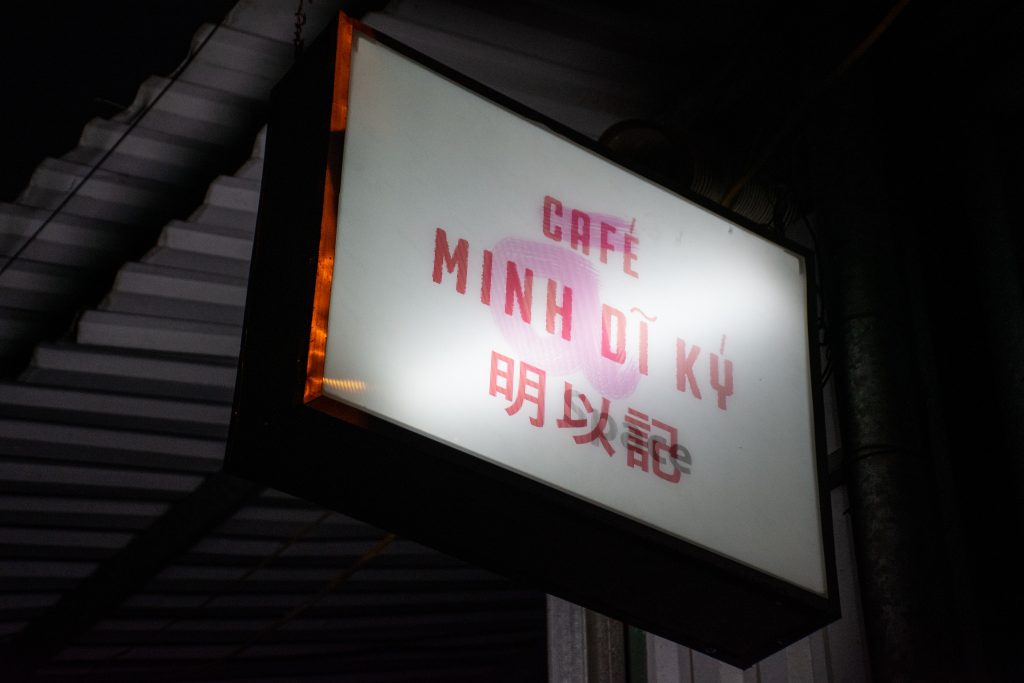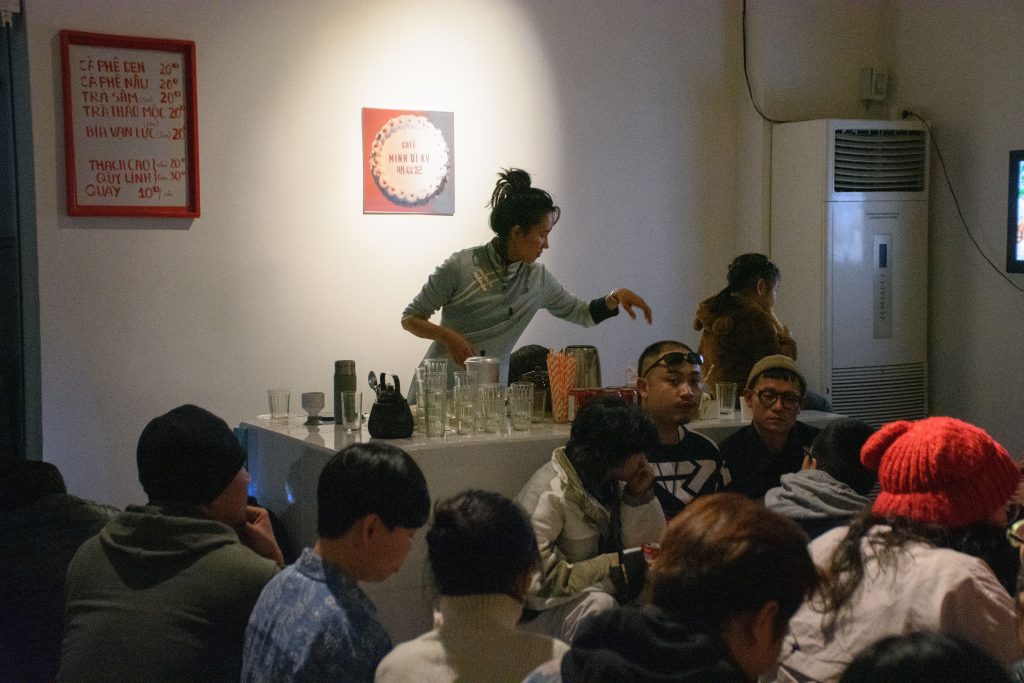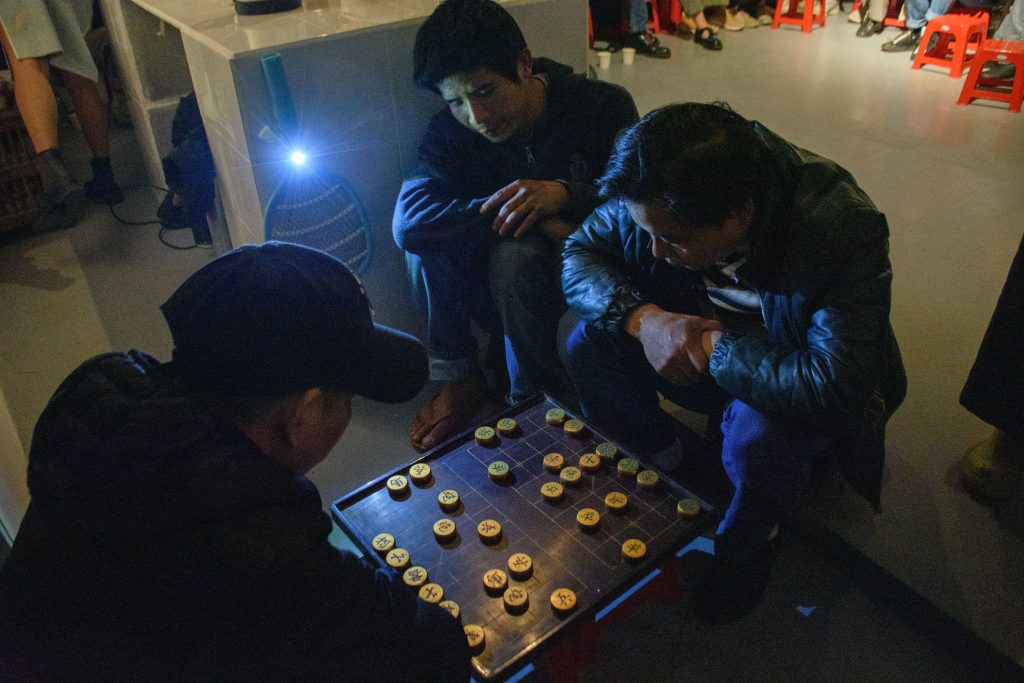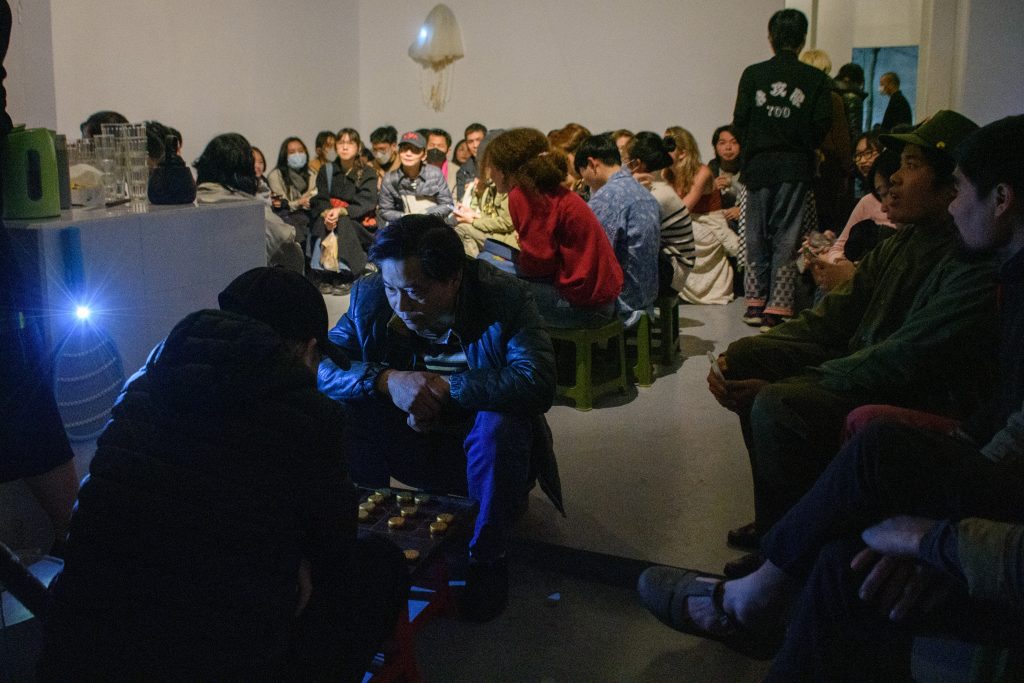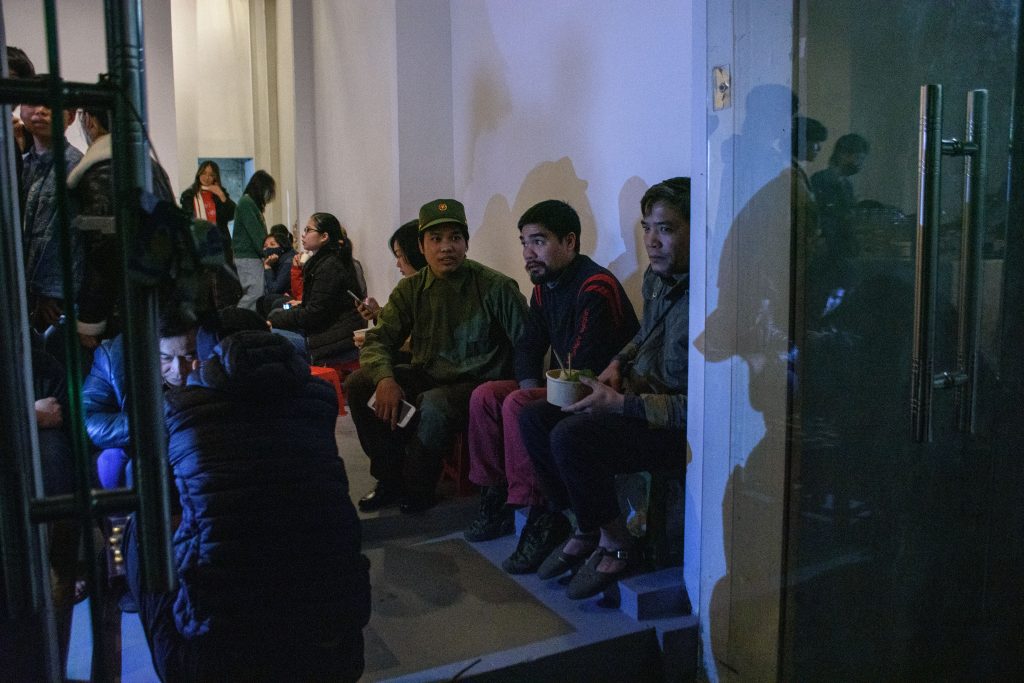This text belongs to Vũ Đức Toàn’s solo show Every Bilious Honeymoon. Translated by Nguyễn Thanh Tâm.
Revisiting Hanoi’s so-called four coffee “pillars”, legend has it there were once 4 legendary coffee shops:
Nhân – Nhĩ – Dĩ – Giảng
Of all these four coffee shops, Dĩ came into life almost a decade later than the other three shops. While the others bounced into life during those 40s-50s, Dĩ came later in the Year of Monkey (1968). Dĩ is how the Hanoian coffee drinkers would usually refer to the coffee shop in short, which was derived from its three-word full name: Minh Dĩ Ký. Traces of its birth and origin exist in only hearsays that have breathed into it a sense of historic mystification. Not only that, Dĩ also ended its operation much earlier compared to Nhân, Nhĩ, and Giảng. On the contrary, these other shops till this day are still becoming more well-known and opening more of their branches. The quadruplet is now reduced to a trio. The vanishing of Dĩ is even more abrupt and truth-loose than its birth.
Harking back to the Year of the Monkey that was regarded as the birth of Minh Dĩ Ký 明以記. People would talk of two men who were identical twins with outward appearances and social footprints standing out to be somewhat peculiar in Chinatown, where they operated a roasting furnace in a narrow studio stretching from Nguyễn Siêu street to Hàng Buồm street. They took on manual roasting services for different types of nuts, chestnuts, melon seeds, corncobs, soy beans, coffee beans… for the Chinese stall-owners.
Until one day, either the older brother or the younger brother picked up incomplete recipes, then made up their beverage so bitter-hell known as coffee, whose taste ushering in a fierce, nostril-burnt aroma differed from that of all of the other Hanoian coffee shops with its price only half the price of the other shops. So through word of mouth, more and more people hustled in the furnace to try out the drink. Initially, the majority of visitors were only from the working class in Chinatown.
Then an event of calamity struck right at the transition period between the Year of Goat and the Year of Monkey. The people of the later generation, especially those born in Chinatown, were always told by their grandparents about a wide-spread and erratic fire in their neighborhood. They talked about the arson that blazed the whole roasting furnace of the twins to ash and then spurted out into the neighboring row of houses. Someone said that it was either of the brothers who set the fire themselves. Some rumored it was unintentionally caused by a child setting off the firecrackers. Some said it was the absent-minded old woman, who lived right off the lane, burning joss papers negligibly… The casualties or the injured in the fire were never mentioned. But since the fire had occurred, when the furnace was displaced with a whole new coffee shop nearby, yet only one brother was still around. It was unbeknownst to others whether that one was the older or the younger brother. But in that fire, there was a spine-chilling detail.
When people around the Chinatown tried to water down the flame, they discovered how behind the roasting furnace were cages of hundreds of rabbits, monkeys, tortoises, turtles… burning with a fussy odor as they screamed. In next to no time the fire already toasted them all alive. Not until the hour of Rat did the fire drown out. Everyone left, face-stained, limb-tired. The whole neighborhood fell into sleep.
When the cock crowed the next morning, the scene of the yesterday fire was unbelievably tidied and by this time there was no remains of the roasting furnace, making the other place look akin to a lane opening way from the Nguyễn Siêu Street to Hàng Buồm Street. Later, the peddlers and the people in the street went back and forth so much more conveniently as it is so commodious that two oxcarts could go through at the same time without collision. The traffic scene of this lane was only bustling during daylight, then suffused with not even a single silhouette by dimming night. In the lane people gradually grew to the habit of burning incense for those animals that were burnt alive. But it is said that in 1978, which was the Year of Horse, the capital blocked this lane to build up a public restroom. Before the groundbreaking ceremony, the neighborhood’s band of performers were so well-intentioned that they poured in the ceremony a sophisticated performance to reenact the fire that was of heart-moving and magical essence. The play had a fairy descending from Heaven to perform rain sprat miracles to put down a fire. Among all the goofy stories about public restrooms in Hanoi exists a story about the cleanest restroom that is not suffused with a smelly odor for most of the time. That restroom is the one above mentioned. People all around the neighborhood never came to that restroom to discharge.
Again talking about the relocation of the coffee roasting furnace to another place after the fire, in fact, it was relocated immediately. Roughly a week later, a few blocks away at the main street where stayed the crossroad Hồng Phúc (now the alley that connects Hàng Đậu street to Hồng Phúc street), either the older or the younger brother inaugurated a spaciously well-conditioned coffee shop, officially harboring the first time the shop had a signboard: 明以記明 Minh Dĩ Ký
It was unlikely in Hanoi to witness any coffee shop’s inauguration ceremony to be such a feast. There were also fireworks and the traditional lion dance… The visitors of the coffee shop kept churning up but those were no longer the ones from the Chinatown, who almost never came in to try that coffee ever since the shop changed its name to 明以記明 Minh Dĩ Ký. The shop indeed has a multitude of names. The regulars called it Dĩ Ký, or sometimes as short as Dĩ. There were locals of the street who never got a sip of coffee but still rather came to play some chess in front of the shop that they referred to as the stoned monkey coffee shop. Some called it Quan Âm (Guanyin) because there was a beautiful pair of Buddha’s Belly bamboo pots placed at the two sides of the door.
Whether or not their coffee bears much difference from the old ones remains unknown but the shop was always bristled with people gliding in from far and wide and their price also made it one of the most high-priced coffee shops in Hanoi. Then during the Year of Rat, the shop was once again struck with another far-reaching disaster. Those callous said it was struck by lightning. Some said the shop was located in the whereabouts of the B52 post-war scatters, some said it was set on fire again. But how bizarre it was that the shop was relocated to nearby the Hàng Bông Street where Thợ Nhuộm bisected Lý thường Kiệt street that, on the right hand was the gate of the December 19th Market, and on the left hand was the Hỏa Lò Compartments. By this time conspicuously the one who stood towering at the shop was neither the older brother nor the younger one but Ms. Minh. Some said Ms. Minh was their adopted daughter, some opposed such, for that her origin remained a myth. The signboard of the shop was now cut straight to only two words left: Dĩ Minh 以明
Many said her coffee is well-tasted and so derivative from the preceding version of Minh Dĩ Ký and the price was no longer so high. But apparently, those who dropped by rarely hailed from the Chinese community.
By the beginning of Year of Horse the shop was abruptly shut down. Some said right before the shutdown, the shop had omitted the two Chinese characters on the signboard whereas only the words Dĩ Minh remained. After a while, they took down the signboard and moved all the stuff elsewhere but still tried to hold out their shop for a short period of time. The takedown of the signboard did not detract from the over influx of customers. An outlandish tale let it be that when the closure of the shop had ushered in for months, by which the only trail behind was an abandoned house draped in incantations and spells and the rumor got around that at times they still caught the glimpse of an old man on the balcony. And those who knew the shop depicted that the crooked and tiny torso must have belonged to either the older brother or the younger one but how mythical it is since a person cannot age so fast into a man of old age as described.
By the end of Year of Rooster, they spread around that the old man was the one who continued to re-open the shop in the Hàng Hương lane that intersects Lý Nam Đế street. The signboard is compressed into only a line on a weaved bamboo sheet saying: coffee and beverage, without any specific name. The coffee drinkers nevertheless definitely knew and still called it the Dĩ coffee but a vast majority of visitors were just inquisitive about the rumor that the man selling was a ghost, and so they would pass by to scan from head to toe the coffee-selling man. By then, rarely did anyone drink at Dĩ. At this time the shop only sold to those regular customers. Those must be special customers endowed with a hard-to-die fate or those who were bold enough. One of whom was Lieutenant Phạm Bính. He usually strolled from the detour by his company (by Nguyễn Tri Phương street) to Hàng Hương Lane and always appeared at the shop by 18:45 and left at 18:55. Between the end of the Year of Tiger and the beginning of the Year of Cat, the shop processed closure and dwelled into forgottenness as time waned and since then no one has any idea about its whereabouts.
Later on, they only speak of a story related to a regular customer who is almost the last one to stick to the shop known as Lieutenant Bính. Some news circulated that he committed suicide in his office by pulling the trigger. His son who was also a high-ranked personnel in no time after his father’s death was taken to an asylum and after a period of time also killed himself there. What is more, one said Minh was by all means a man. She is all the way girlish and enamored with gussying up, red-lipped chewing on the betel nut all-day, so when people called her ‘she’, she would be so fond of such.
Such a shame not to mention a figure named Bổng in Gạch Ward, alias Bổng chồn (blinky Bổng). People in the neighborhood called him so since he had the predisposition to blink his left eye nonstop. He was a notorious nepotism son and was also one of the beneficiaries who donated some ounces of gold to the district municipality’s theatrical play of the said fire. Around the end of the Year of Snake, after a business itinerary in Tam Kỳ, he came back mostly doing business ventures with the Hanoian connoisseurs of drinks. He narrated to them time and again all sorts of hard-to-buy tales. If there is really a coffee snob of the Central then they would know about a long-standing shop in Tam Kỳ Quảng Nam that withstood the test of time ever since the 60s. The shop is called Hồ Tôn Ký. The owner Hồ was often called by the regulars as Hai Uncle, as he was described as looking exactly the same as the legendary uncle Hai Đạo Dừa in Gò Công with his scoliosis-bent torso and the pell-mell shoulder bones. The locals also called this place with other names such as a glass-painting coffee shop, because, albeit its cramped area, the shop had a really large-sized worshiping painting billed after a beauty-bristling archetype of glass painting. The worshiping painting venerated three animals, which on the left was a Rabbit, on the right a Turtle and and in the middle a Monkey. When many people later on still chatted about the coffee of animals nearby the vicinity of Da Liễu, it was definitely Hồ Tôn Ký they were talking about. By the end of the 70s this place no longer existed. It is heard that the owner crossed the border then eventually went missing out there in Nam Hải. As time stretches, Tam Kỳ is finally recognized as a city, the vicinity became the nowadays Nguyễn Văn Trỗi wherein behind stayed a mixed sweet soup shop of Ms. Minh that always galvanized mobs of students. Those often referred to the mixed sweet soup with an undignified name: You Lost Me or I Lost You, or such. This place apart from sweet soup also had those of flavor distinction like Cao Quy Linh Jelly, or Chí Mà Phù that even the grey-haired love let alone the batches of students. People often mentioned a tale, real but ridicule-filled, that left everyone bewildered. It was by the time the shop had just been renovated, in which a worker at the shop dragged an adolescent to the police station. This was the one who went all the way from Hanoi to write bullshit on the newly white-painted wall of the shop which later on got caught red-handed with an exhibit as a piece of brick. The adolescent clipped the vowels unintelligibly and always exhibited painstakingly slow manners. He admitted to doing it for promised money. He disclosed that this person gave him an ounce of gold while pointing his hand to the white-lit patch of fingerskin embedded with the shape of a long-worn ring. Asked where the ring was, the person shaked his/head, pointing his/her finger all over the place. Whether the one who talked him into committing the act is a woman or a man remains unknown. He only said that the person ordered him to do this do that and gave him a piece of paper to write it off the wall beautifully. The whole police station had no idea of Chinese characters/symbols/words to comprehend what was written. Dragooned into answering, the boy finally bursted out the answer that got the whole police station a great deal of laughter. In short the line of red words orderly brick-written on the white wall has an arrow pierced through a heart:
以,我失去你了 ![]()

 VN
VN
